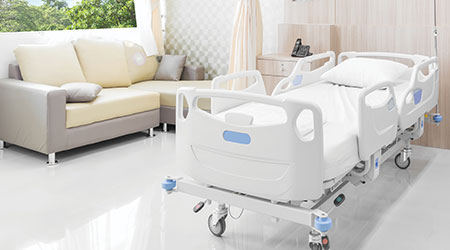
A patient’s room in a hospital contains a variety of hard and soft surfaces: walls, furniture, finishes, patient-care equipment, privacy curtains, bed linens and other sundry items. Studies show that facility executives in hospitals and healthcare facilities are more concerned with cleaning and disinfecting hard surfaces.
According to the “Cleaning Costs And Frequencies Report” published by Contracting Profits and Facility Cleaning Decisions, 46 percent of hospitals spec to have environmental service departments clean and disinfect hard surfaces multiple times a day. Another 46 percent have these surfaces cleaned and disinfected daily.
Soft surfaces, on the other hand, don’t receive anywhere near this amount of attention. Only 8 percent of facilities spec to have soft surfaces cleaned and disinfected multiple times a day; 10 percent require it on a daily basis.
Soft surfaces are underappreciated risks to patients, staff and visitors. From carpets and upholstered furniture, soft surfaces, like hard surfaces, are potential reservoirs of harmful bacteria that can cause infections in patients with compromised conditions. Many types of potentially harmful bacteria can survive on soft surfaces including MRSA (Methicillin-resistant Staphylococcus aureus), VRE (Vancomycin-resistant enterococci), and C-auris (Candida auris).
In addition, these pathogens can survive on soft surfaces for days to months. These surfaces are “high-touch” fomites (inanimate objects that can transfer pathogens from a surface to human’s hands or compromised skin). Soft surfaces that cannot be laundered (e.g., patient linens, privacy curtains) are often ignored or improperly disinfected.
Hospital staff members know they have a problem. A survey says 74 percent of healthcare professionals would be concerned about touching upholstered furniture if they were a patient visiting a hospital. In addition, 59 percent of healthcare professionals would be concerned about touching privacy curtains if they were a patient visiting a hospital.
These people have a right to be concerned. The same survey says only one in five healthcare professionals cleans soft surfaces as frequently as hard surfaces. Two in five healthcare professionals clean or disinfect privacy curtains less than once a month; and half of respondents say they lack additional time needed to clean or disinfect soft surfaces.
Knowing there is a problem isn’t enough to fix the situation. Unfortunately, nearly half of the survey respondents say their current cleaning supplies are not effective for disinfecting soft surfaces and one-third say they do not have the tools or products they need to safely and effectively clean or disinfect soft surfaces.
The Problem With Sanitizing Soft Surfaces

 The Down and Dirty on Cleaning in Virus Season
The Down and Dirty on Cleaning in Virus Season How Surfactant Use is Expanding in Commercial Cleaning
How Surfactant Use is Expanding in Commercial Cleaning